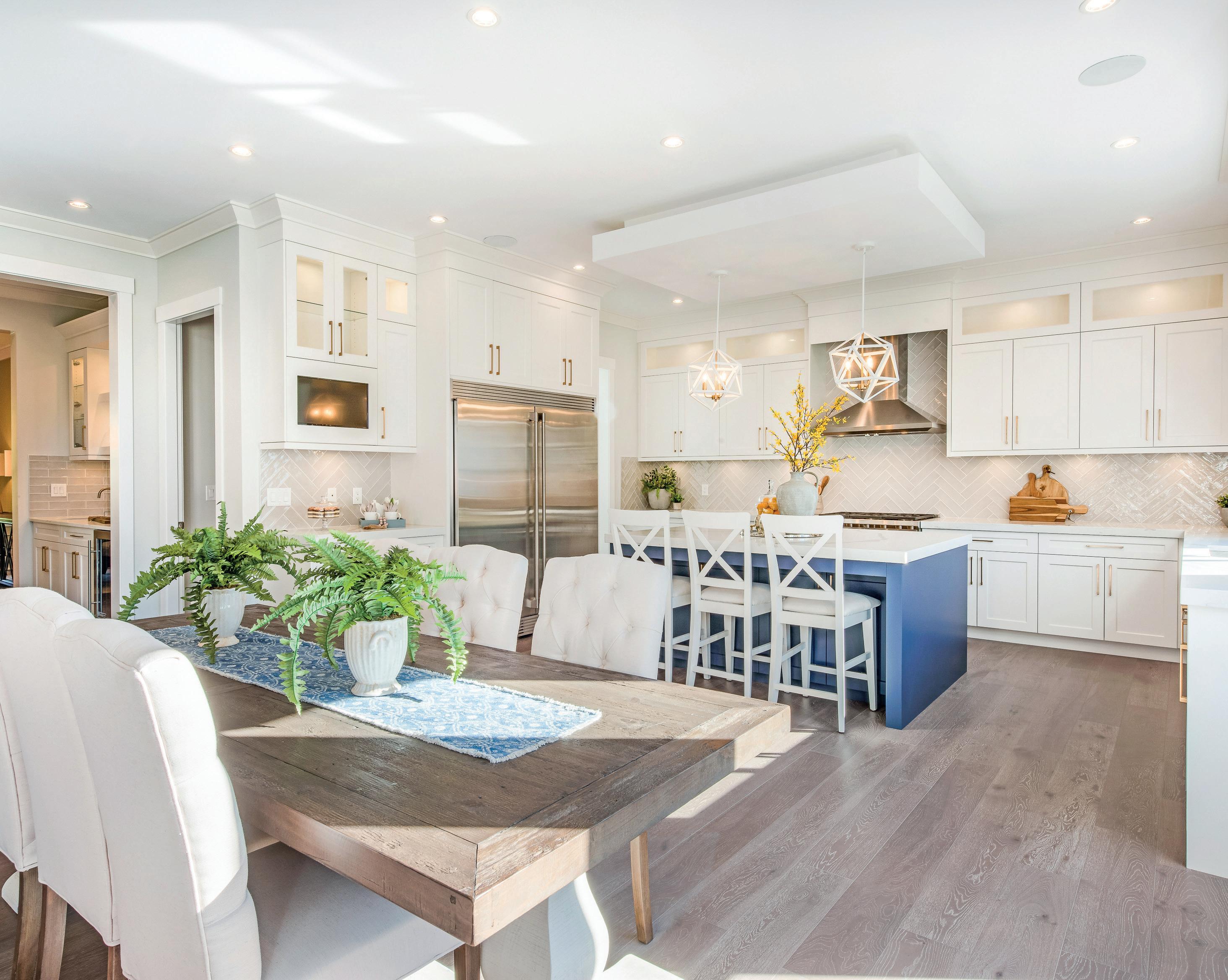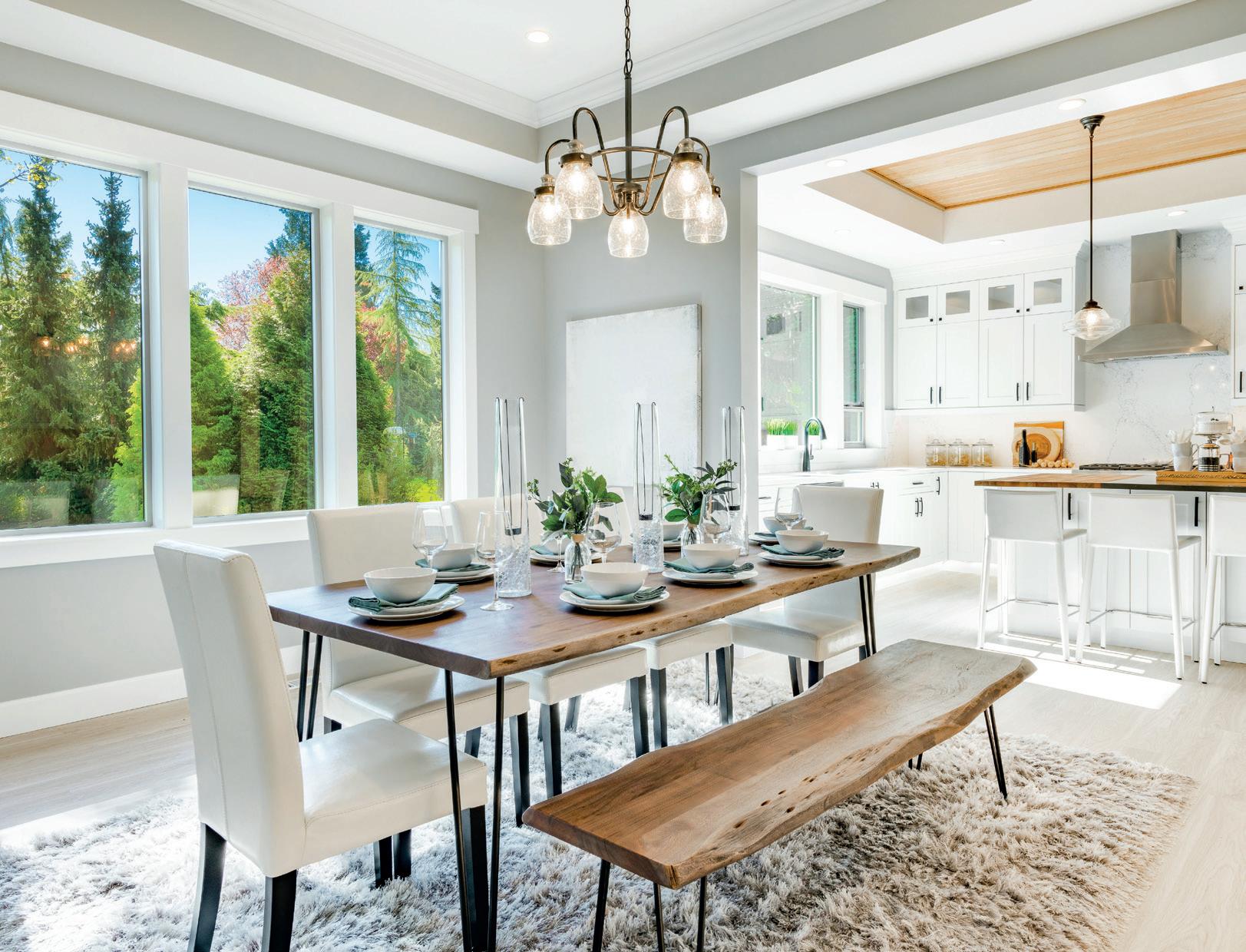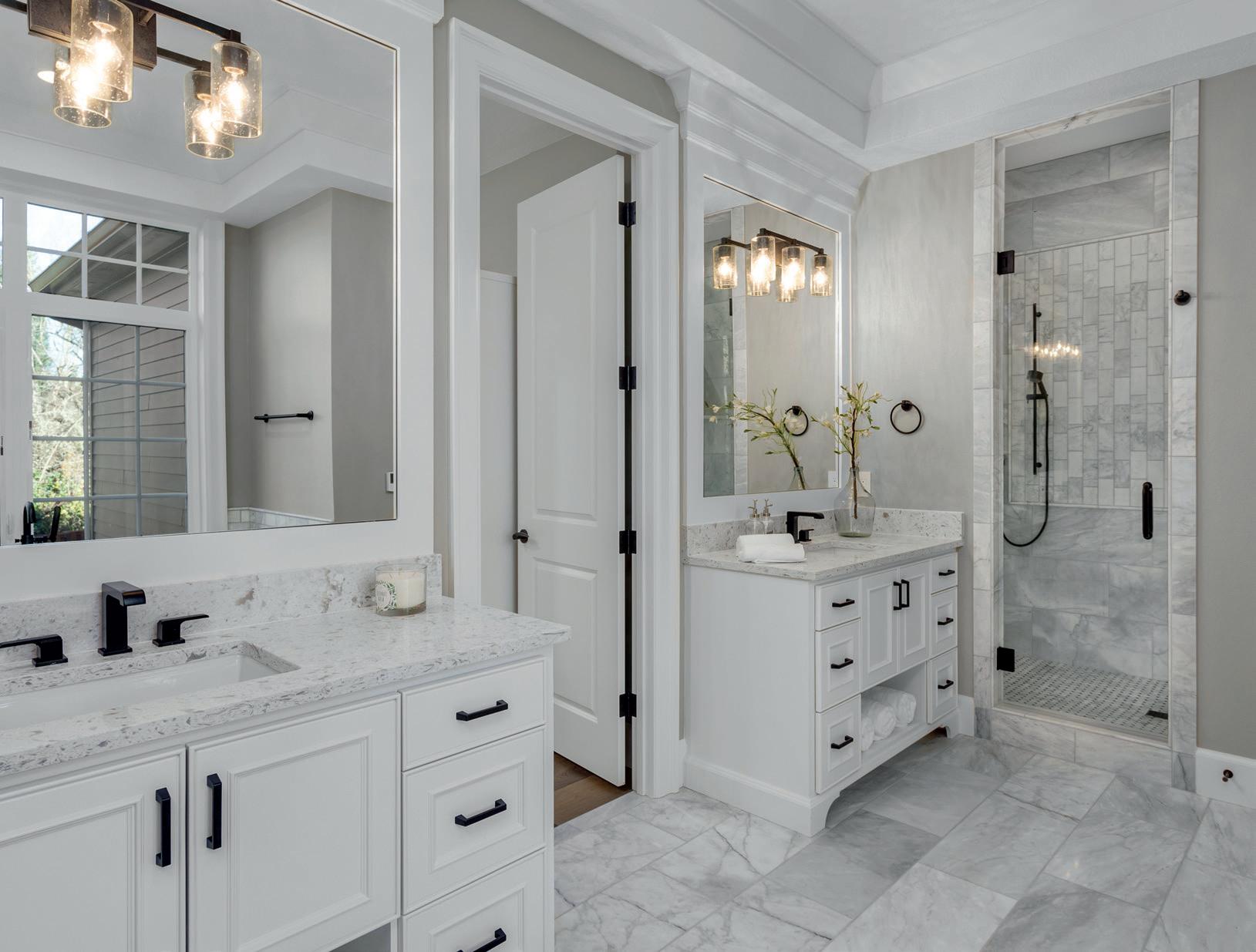STAGING GUIDE
ENTRYWAY
A welcoming entryway is full of space, light, and typically a beautiful object or piece of art. No matter how big or small, entryways should signal a sense of arrival and set the tone for your entire home. Even the smallest entry can feel open with a large mirror, table lamps, and walls in a pale tone. A wooden tray to hold keys, mail and phones will help contain the clutter.
Even inside, a fresh indoor-outdoor area rug with a pattern in earthy colors will warm the space as nicely as it contains the dirt from the busiest in-person open houses. Just make sure its pile is low enough for the front door clearance.
The front door itself – including the doorknob and locks – is the first and last place of a home a person will literally touch. So, make sure the entire door is clean or repainted inside and out, the locks work perfectly, and the knob or lever feels solid to give the impression of a well-maintained home.
LIVING ROOM
How many people will likely occupy this home? Provide enough seating for that number plus a couple of guests so potential buyers can visualize their family relaxing together. A sectional, even if it’s a small one, looks luxurious, inviting, and sometimes less cluttered than a separate sofa and armchairs. Consider angling it slightly to face both the TV or fireplace, as well as the place where people generally would enter the room.
A generous coffee table is appealing to both families with kids as well as couples who entertain regularly. Add end tables sparingly to keep the floor looking open, but don’t leave a chair on its own without a place to set a coffee cup nearby. Floor lamps are great ways to add light without adding extra end tables. Fill bookcases only about a third of the way to give the sense of lots of available storage space. If your books don’t look coordinated, an easy trick is to turn all the jackets inside out. It gives the shelves a more modern, unified look.
Use books in good condition only, and let artful objects such as these handwoven baskets and accessories add variety and texture.
www.jenniferadams.com/products/medium-silver-blue-umuseke-basket
DINING ROOM
The dining room is definitely still a thing! Even if it’s going to be used just once or twice a year for entertaining, most buyers still want to have that option. For most average size homes, choose a standard height table that can seat six people with lots of room to move around or expand for more people. Space is more important than the extra chairs, so consider using four chairs and a bench at the front side of the table for a cleaner, welcoming look.
If there is room, use a buffet cabinet that is no higher than a counter. Tall furniture seems to loom overhead and make the room feel smaller, especially if it is dark-colored. Instead, add a beautiful mirror and a graceful pair of lamps for an airy feeling and extra light.
It’s not necessary to stage the table with dishes and glassware. Instead, let the potential buyer envision their own family and personal dishware at the table.
KITCHEN
Clean, clean, clean everything, including the light switches, insides of all the drawers, appliances that are staying, and under the sink! Most buyers want to move right in, not spend time cleaning first. New shelf paper and paint can do a lot to update older cabinets if a remodel isn’t in the budget.
Keep the counters clear except for one or two vignettes, such as a coffee maker in a logical place along with a couple of cups.
A bag of freshly ground coffee is an inviting aroma to most and also helps mask other odors! And seeing one such appliance shows how much room is on the counter.
Accessorizing with fresh lemons in a bowl or tall branches in a simple vase is a great way to add texture and interest without adding clutter. And, these are low maintenance, hypoallergenic, and will look (and smell) great in-between showings!
BEDROOM
The bedroom should be all about sleeping and relaxing. Think everything soft, calm, and tranquil. Pale neutral colors along with rich textures are just as inviting as they are soothing.
In any bedroom, the bed should be the star of the entire room. In the main bedroom, leave enough space on both sides for nightstands. A lovely headboard with just a simple bed frame keeps the room looking more open than a bed with posts or a footboard.
Consider staging a queen-size bed rather than a king for a more spacious feel in smaller main or guest bedrooms, along with beautiful, fluffy linens that just make you want to crawl right in. Add at least four sleeping pillows, a few accent pillows, and a luxurious throw blanket.
Besides the bed, include a pair of nightstands, each with its own lamp and a low dresser, also with a lamp. Other furniture could include a bench at the end of the bed only if there is lots of room to walk around it, and perhaps a reading chair with an ottoman, end table and floor lamp. Leave out desks, exercise equipment and other non-sleeping or clothing storage furniture.
Kids’ rooms look good with a single twin bed loft to create a spacious view of the floor. Keep the overall décor in tune with the style of the house -- avoid obvious young kid themes such as dinosaurs because some buyers have teens, not toddlers. Accent colors can be brighter, however. A full-size bed could be in large-sized rooms for teenagers or college-aged kids. Other bedrooms should be staged as standalone guest rooms OR an office (or other functions such as exercise, yoga, etc.), but not a mix.
Contrast neutral walls and other earthy tones with a bit of color on the bed, such as white contrasted by clay tones as in this Lux Collection Solid Sheet Set from Jennifer Adams, or in navy or slate blue.
www.jenniferadams.com/products/lux-sheet-set
HOME OFFICE
It wasn’t very long ago that a home office was an optional feature, not a requirement! But now, many households have at least two office setups, not to mention space for kids to do their schoolwork. For staging, consider one dedicated space with a door – such as a bonus room, den or bedroom, and another table in the formal living room. For example, a sofa table could do double duty, or a small dining table in an otherwise awkward corner of the living room would work, too.
Stage home office furniture that blends with the décor style of the house and doesn’t look like real office furniture. As most of us know, wood dining tables work quite well as desks! They also are more useful sizes and look nicer than office-beige laminates. Choose a table/desk about 4-5 feet wide and 30-ish inches deep, unless the room is quite large. That’s enough space to visualize getting work done without dominating even a small room.
The desk chair should be ergonomic but made of wood and upholstery, not plastic and mesh fabric. Low open shelves or cubbies provide storage as well as a surface for supplies.
OUTDOOR LIVING
Outdoor spaces and home offices have earned their keep recently and are on the wish list of many home buyers! Emphasize good connections between outdoor living spaces and indoor ones with shared views and easy access off the kitchen or great room. If the backyard is small, start with at least a dining area. Bigger yards can have an outdoor living room as well, complete with a sofa or sectional, armchairs, coffee and end tables, and an area rug!
Outdoor kitchens are also a smoking hot trend but will be expensive to put in just to sell a home. So let the new buyers go down that path if they want. Instead, go with a casual outdoor cooking area with a handsome new or thoroughly cleaned grill, charming cooler, and a trolly cart for food prep or as a drink station.
Revitalize and clean existing patios and decks to look almost as good as new. Budget allowing, patio pavers or a new wood deck where there was none will create a sturdy place for the furniture and helps define the “room.” Or with a pad of ¾” gravel edged with pavers, brick or flat stones to contain the gravel physically and visually.
BATHROOM
Staging a large bathroom is easy – once it’s cleaned thoroughly, it will already have a fresh, airy spa-like feeling. But what should you do with a small bathroom? First, emphasize a clear view of as much of the floor and walls as possible. No area rugs or shower mats. Replace frosted glass shower doors with clear glass or a shower curtain that will allow a view all the way to the far wall.
If there’s a budget for new fixtures, consider a pedestal or wall-mounted sink as wide as possible. Just because the bathroom is small doesn’t mean the sink has to be.
Consider a space-saving wall-hung toilet, towel hooks instead of racks, and open shelves with attractive baskets over closed cabinets. Modern medicine cabinets add storage and are a perfect way to keep clutter out of view. Some even have outlets built into them to charge toothbrushes, shavers, etc.
If possible, adding natural light will create a worthwhile connection to the outdoors. A small 2 ft x 2 ft skylight with a view to the sky or a window high on the wall are options that allow for privacy as well as light and reduce the need for window treatments.
Additional mirrors will also multiply light; consider using a collage of smaller mirrors in various sizes on the wall as art. Keep frames consistent, at least in a color two shades darker than the walls or in a matte silvery metallic, or skip them altogether. Finally, consider beveled edges to create even more sparkle!
Towels should be all white to reduce visual clutter, but a little bit of tonal texture keeps things interesting, such as the stripes in the Kensey line of towels from Jennifer Adams.
www.jenniferadams.com/products/kensey-bath-towel
Keep colors muted, both on the walls and in accessories. Too much color and pattern can make a small bath feel even smaller. Good colors for bathrooms will bring the outdoors in, such as a warm sandy color, soft teal, navy blue or grayish-green or blue tones. One dramatic statement, say, in the shower curtain, will be plenty. Even so, keep the pattern large-scale but simple and in just one or two muted colors max. Then, tie in that color with the accessories such as a soap dish, vase or other artful treasure.
PRO TIPS FOR STAGING
The Rule of Threes! Items look best clustered together in odd numbers, especially in varied sizes.
For example, in the living room, a chair, end table, and lamp will be a cozy place to read a book or be part of a conversation. Or a stack of three books on a table, three candles or artful objects on a shelf.
In any room, neutral, pale tones such as a soft, warm gray on the wall contribute to an airy, clean cohesiveness that can be personalized later. Even though most of us know that paint is easy to change, a bold accent wall or room in a bright, trendy color can still turn somebody off to the whole house!
Add color with accessories rather than on the walls. Repeat the same color throughout the room at least three times to help guide the eye.
Throw pillows, art on the wall, accents in the area rug, and a large vase or other treasure are good examples for the living room. In bedrooms, a comforter set such as the “Avalon” by Jennifer Adams, throw blankets, and accessory pillows are good places for color.
www.jenniferadams.com/products/ printed-duvet-cover-sham-set
Unless they are built-in, use only low storage furniture pieces such as media cabinets, buffets and bookcases. This will allow a person’s eye to go all the way to the walls, which makes the room feel much larger and more open. Tall, boxyshaped furniture such as armoires and china hutches visually occupy a lot of space in a room, especially if darker than the walls.
Clean, repair or replace the light switches, cabinets and doorknobs, and faucets! Lots of buyers these days aren’t into fixing anything. And, it’s incredibly annoying if these types of things are crooked or don’t work. Having the items that people touch frequently feel and look good is reassuring in the overall quality of a home.



























